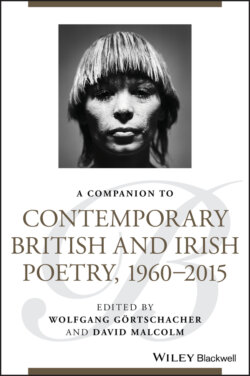Читать книгу A Companion to Contemporary British and Irish Poetry, 1960 - 2015 - Группа авторов - Страница 25
Linton Kwesi Johnson, “Inglan Is a Bitch” (1980) (Johnson 1991, 13–14)
ОглавлениеThe contestation of tradition and authority noted in poems discussed earlier meets the reader (or listener) full in the face in Johnson's poem. It is a radically disruptive piece of work (as befits its speaker, his situation, and his view of the world).
This is most obviously manifested in language. The poem is in Jamaican patois, and the deviance from standard English is flaunted at almost every level: orthography (England becomes “Inglan”), phonology (the underground is rendered as “andahgroun”), and grammatical structure (“do not get fi know” [do not get to know] is not a recognized structure in standard English, although something similar exists in other English insular dialects). These examples are drawn from the first stanza. The language of the whole poem is thus (it is interesting to note that the poem shows no lexical deviance from standard English—unlike Hill's and Harrison's work).
Contestation of tradition is also present in the poem's status as a piece meant for oral delivery and public performance. In respect of poems discussed earlier, Heaney, Hughes, and Harrison are known as charismatic and powerful readers of their verse, but most encounters with their work are visual rather than aural. Johnson's poem is also a printed text, but its existence as a sung version with music (on the record Bass Culture [1980]) and its identification as dub poetry, which is often accompanied by music, place it within a different order of orality. Its public and performance aspect is apparent in its refrain (half the poem) and in its constant repetitions (for example, “well mi duh day wok an' mi duh nite wok / mi duh clean wok an' mi duh dutty wok” [stanza 9]), both well‐attested features of oral narrative and lyric production. A surprising feature of the readily available recordings of Johnson's own performances of the poem is his relaxed, slow, benign, almost weary manner of rendition, which adds a level of meaning to the text, a gentle rhythmic quality that one might not expect.
The text plays fast and loose with established poetic tradition, too, in its freedom with rhyme. Although four stanzas rhyme aabb, there is a variety of rhyme schemes—aaaa (stanza 1), aabb‐ (stanza 5), ‐a‐a (stanza 7). Indeed, sometimes repetition is used instead of rhyme—for example, “Inglan is a bitch” in several versions of the refrain, and the first two lines of stanza 9 (“nite wok / dutty wok”). Some line endings that are presented as rhymes would not count as such in much poetry—for example, stanza 12, “escapin it / fram it.” At one point, the poem slips into an irresistible internal near‐rhyme—stanza 11, “faktri / Brackly / crackry.” Surprisingly, line length is not extremely variable. The lines of the refrain are shorter than those in the rest of the text, but they are consistently so. The line length is reasonably regular, certainly within individual stanzas, and usually fluctuates only between 8 and 10 syllables, although there are much longer lines (for example, the last line in stanza 9, or the second line in stanza 11). Main stress placement again shows some variation, but is not nearly as disordered as, for example, Hughes's “Crow Tyrannosaurus.” A majority of lines have three main stresses, although there are lines that rise to five stresses (stanza 13, last two lines, or stanza 9, first two lines). The poem's status as a piece for oral performance complicates the issue of stress placement, as this is a feature (among others) that can vary radically even among the renditions of the same performer.
All these technical features are aspects of the poem's whole contestatory purport: it is the voice of the West Indian working‐class diaspora, a marginalized voice of a marginalized community, insisting here on being listened to and taking its place in the literary world. Stanzas 11 to 13 enunciate part of the world of someone from this community—15 years of work in a factory, pushed out on public relief at 55—although, in fact, such experience is not limited to workers of West Indian heritage in Britain.
Yet, this text is not without its traditional and established qualities. There is a long tradition in English of public verse drawing on the experiences of working‐class and marginalized groups. The ballad‐like beginning of stanza 1 (“w'en mi jus' come to Landan toun”) echoes a host of working‐class and, for example, Irish pieces about emigration to the big city. English poetry also has a strong tradition of political verse, and at least some of that rendered in nonstandard language. John Davidson's “Thirty Bob a Week” (1894) and Hamish Henderson's “Freedom Come All Ye” (1960) are examples that spring readily to mind. As we have pointed out in the earlier text, main stress placement is not very variable, especially in the refrain. The poem's rhymes are mostly full, although the last line in several versions of the refrain (“fram it”) is not, and nor are the rhymes in lines 3 and 4 of stanza 5 (“meet / sleep”). But despite these mainstream orderly aspects of the poem, it is still a rebarbative, contestatory piece, rattling at the doors of English literature (which has, of course, opened those doors to it in the subsequent 50 years).
